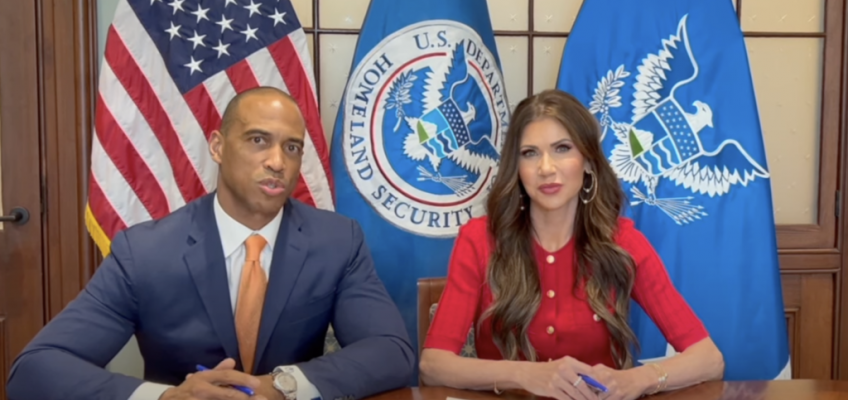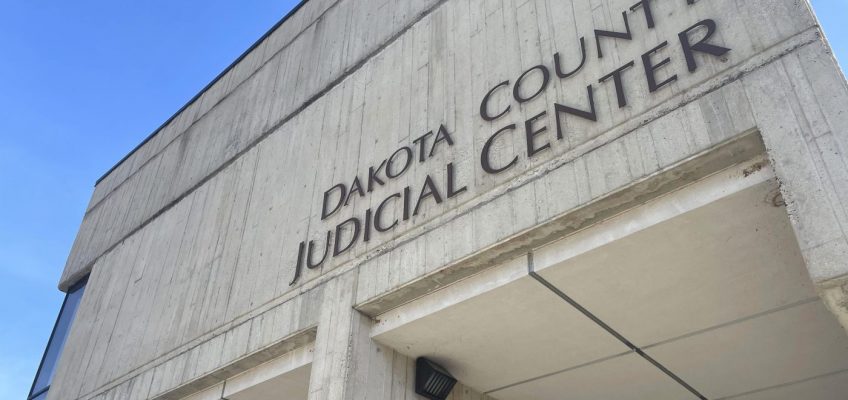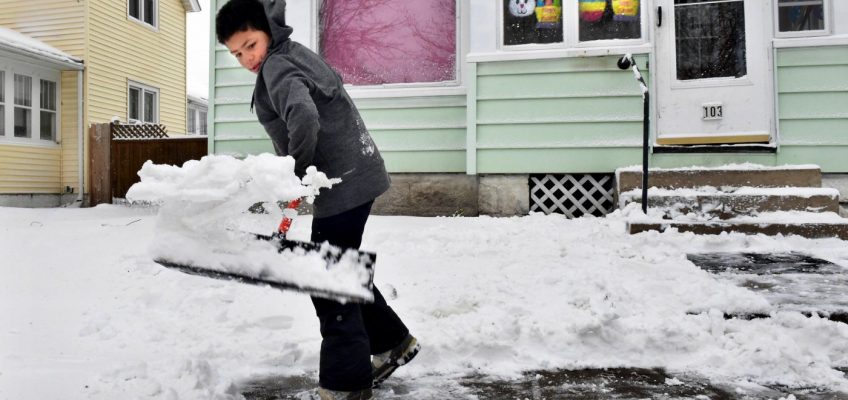According to advocates who spoke with City Limits, the memorandum is yet another effort by the Trump administration to target immigrants and doesn’t constitute a basis for eviction.
HUD Secretary Scott Turner and DHS Secretary Kristi Noem announcing the “American Housing Programs for American Citizens” memo on March 24, 2025. (YouTube/HUD)
On March 24, the U.S. Department of Housing and Urban Development (HUD) announced a partnership with the Department of Homeland Security (DHS), which will create “a point of contact” between the two federal agencies to share data about undocumented immigrants living in government-subsidized housing.
“By working more closely together and with greater collaboration, we will identify illegal aliens who are ineligible for Federal housing assistance and take remedial measures to end this waste and abuse, including referral for immigration enforcement actions,” reads the Memorandum of Understanding, or MOU.
But local officials are so far unsure of what the memo, dubbed “American Housing Programs for American Citizens,” means for their agencies and the city’s sanctuary laws.
Undocumented people are already prohibited from receiving federal housing subsidies directly. Eligibility for federal housing assistance is limited to U.S. citizens and non-citizens with a qualifying immigration status, such as a lawful permanent resident (also known as a “green card” holder), refugee or asylee, among others, according to advocates and the city’s Department of Housing, Preservation and Development (HPD).
Immigrants who don’t qualify, however, can live in a household that receives a federal subsidy as long as other members of that household qualify, with the amount of aid based on the number of people who are eligible.
For instance, if an immigrant without legal status is living with U.S born children who qualify, the household would receive a smaller subsidy and pay a higher portion of the rent to take the ineligible family member into account. This is known as prorated support.
“Their assistance is already pro-rated to only cover eligible household members,” the Alliance for Housing Justice, a national advocacy group, said in a statement last week in response to the memo, saying HUD Secretary Scott Turner is “misrepresenting how his agency’s programs actually work.”
“This isn’t about program integrity—it’s about surveillance, fear, and falsely blaming immigrant families for the failures of a housing system that puts profits over everyday people,” the group said.
A HUD spokesperson said that “the purpose of the MOU is to establish information sharing between HUD and DHS to ensure illegal aliens are not in public housing,” but did not elaborate.
According to Anna Luft, project director of the New York Legal Assistance Group’s Public Housing Justice Project, the memorandum applies to all HUD-subsidized housing, including Section 8—also known as the Housing Choice Voucher Program, which provides rental assistance to low- and moderate-income families—and public housing authorities that run such programs.
In New York City, there are three major public housing authorities: The New York City Housing Authority (NYCHA), which administers a Section 8 program as well Section 9 public housing developments, HPD, and the Division of Housing and Community Renewal (DHCR), which is part of the the state’s affordable housing agency, New York State Homes and Community Renewal (HCR).
Only HPD said it falls within the scope of the MOU. A NYCHA spokesperson said, “NYCHA is not a party to this MOU,” despite being the largest public housing agency in the city. An HCR spokesperson did not specify what the MOU means for its programs, only saying that “as we continue to monitor the impact of these actions, Governor Hochul is fighting to ensure the safety and wellbeing of all New Yorkers.”
According to advocates who spoke with City Limits, the memorandum is yet another effort by the Trump administration to target immigrants and doesn’t constitute a basis for eviction. Even before the election, Donald Trump was on the campaign trail blaming immigrants for the “housing crisis” and the “rising housing costs,” even though economists and researchers disagree.
Like many of Trump’s proposals in his second term so far, this one has roots in his first time in office. In 2019, the Trump administration proposed a policy rule change that would have essentially banned families with mixed immigration statuses from living in public or federally subsidized housing. In 2021, the Biden administration withdrew Trump’s proposed rule, so it was never implemented.
A 2019 HUD regulatory impact analysis estimated that approximately 25,000 households receiving a federal subsidy nationwide had at least one ineligible member.
“Geographically, 72 percent of mixed families are concentrated in three states—California (37 percent), Texas (23 percent), and New York (12 percent)—while the rest is scattered around the country with 3 percent or less mixed families per state,” reads the HUD’s analysis.
An HPD spokesperson reiterated that HUD regulations for federal rental subsidy programs, including Section 8 vouchers, already limit eligibility to households with at least one member who has a qualifying immigration status, with the housing subsidy a household receives prorated based on the number of eligible members.
In NYC, HPD provides rental vouchers, including Section 8, to a total of 42,000 households, a spokesperson detailed. Of those, approximately 5,900 have members with eligible immigrant status, and about 350 Section 8 households are of mixed immigration status.
It’s unclear whether the city’s sanctuary laws, which restrict local agencies from sharing identifying information with federal immigration authorities, might play a role under the new data-sharing agreement and if so, how.
Because households must declare their citizenship and eligible immigration status when applying, HUD already has information on the immigration status of households receiving federal housing benefits, according to HPD, NYCHA, and advocates.
Both HPD and NYCHA must report citizenship status information to HUD, per HUD voucher rules, spokespersons for both agencies explained. HPD added that the actual impact of the MOU will depend on how that information is used by HUD and DHS.
The memorandum details that HUD is devoting just one full-time staffer to this data-sharing effort, to “help stem the tide of illegal immigration in the United States and incentivize illegal aliens to voluntarily depart the country, we enter into this MOU,” it reads.
An HPD spokesperson said HUD hasn’t contacted local agencies about the measure, and since the MOU is very new, its goal right now is to gather information, avoid causing harm or panic, coordinate with partner public housing agencies, and then communicate with clients (though the agency did not provide details on those communication efforts).
As this is the first time this memorandum of understanding has been in effect, there is a great deal of uncertainty. Advocates recommend that households consult with immigration attorneys for individualized assessments.
“Our advice for people who are concerned and are living in HUD subsidized housing,” Luft said, “is for them to talk to their immigration attorneys and assess what their individual removal risk is and what they should do.”
To reach the reporter behind this story, contact Daniel@citylimits.org. To reach the editor, contact Jeanmarie@citylimits.org
Want to republish this story? Find City Limits’ reprint policy here.
The post HUD Struck a Data-Sharing Agreement With Immigration Enforcement. What Does it Mean for NYC? appeared first on City Limits.




